机器学习(Andrew Ng)作业代码(Exercise 1~2)
Programming Exercise 1: Linear Regression
单变量线性回归
warmUpExercise
要求:输出5阶单位阵
直接使用eye(5,5)即可
function A = warmUpExercise()
%WARMUPEXERCISE Example function in octave
% A = WARMUPEXERCISE() is an example function that returns the 5x5 identity matrix
A = [];
% ============= YOUR CODE HERE ==============
% Instructions: Return the 5x5 identity matrix
% In octave, we return values by defining which variables
% represent the return values (at the top of the file)
% and then set them accordingly.
A=eye(5,5);
% ===========================================
end
plotData
要求:读入若干组数据(x,y),将它们绘制成散点图
使用MATLAB的plot()命令即可
function plotData(x, y)
%PLOTDATA Plots the data points x and y into a new figure
% PLOTDATA(x,y) plots the data points and gives the figure axes labels of
% population and profit.
% ====================== YOUR CODE HERE ======================
% Instructions: Plot the training data into a figure using the
% "figure" and "plot" commands. Set the axes labels using
% the "xlabel" and "ylabel" commands. Assume the
% population and revenue data have been passed in
% as the x and y arguments of this function.
%
% Hint: You can use the 'rx' option with plot to have the markers
% appear as red crosses. Furthermore, you can make the
% markers larger by using plot(..., 'rx', 'MarkerSize', 10);
figure; % open a new figure window
data=load('ex1data1.txt');
[n,m]=size(data);
xdata=data(:,1);
ydata=data(:,2);
for i=1:n
plot(xdata,ydata,'rx');
end
xlabel('X Axis');
ylabel('Y Axis');
% ============================================================
end
输出结果:

computeCost
要求:读入\(m\)组数据(X,y),计算用\(y=\theta^T X(\theta=(\theta_0,\theta_1)^T,X=(1,x^{(i)})^T)\)拟合这组数据的均方误差\(J(\theta)\)
function J = computeCost(X, y, theta)
%传入:X为m*2矩阵,每一行第一列为1,第二个为X值,y为m维行向量,theta为二维列向量
%COMPUTECOST Compute cost for linear regression
% J = COMPUTECOST(X, y, theta) computes the cost of using theta as the
% parameter for linear regression to fit the data points in X and y
% Initialize some useful values
m = length(y); % number of training examples
% You need to return the following variables correctly
J = 0;
% ====================== YOUR CODE HERE ======================
% Instructions: Compute the cost of a particular choice of theta
% You should set J to the cost.
for i=1:m
J=J+(theta'*X(i,:)'-y(i))^2;
end
J=J/(2*m);
% =========================================================================
end
gradientDescent
要求:给出m组数据\((x^{(i)},y^{(i)})\),学习率\(\alpha\),梯度下降法迭代num_iters次后返回最终的参数\(\theta\)和每次迭代后的均方误差损失J_history
公式推导:
梯度下降过程中,每次迭代同时更新\(\theta_0,\theta_1\):
function [theta, J_history] = gradientDescent(X, y, theta, alpha, num_iters)
%GRADIENTDESCENT Performs gradient descent to learn theta
% theta = GRADIENTDESENT(X, y, theta, alpha, num_iters) updates theta by
% taking num_iters gradient steps with learning rate alpha
% Initialize some useful values
m = length(y); % number of training examples
J_history = zeros(num_iters, 1);
for iter = 1:num_iters
% ====================== YOUR CODE HERE ======================
% Instructions: Perform a single gradient step on the parameter vector
% theta.
%
% Hint: While debugging, it can be useful to print out the values
% of the cost function (computeCost) and gradient here.
%
dJ_dtheta0=0;
dJ_dtheta1=0;
for i=1:m
dJ_dtheta0=dJ_dtheta0+(theta'*X(i,:)'-y(i));
dJ_dtheta1=dJ_dtheta1+(theta'*X(i,:)'-y(i))*X(i,2);
end
dJ_dtheta0=dJ_dtheta0/m;
dJ_dtheta1=dJ_dtheta1/m;
theta=theta-alpha*([dJ_dtheta0,dJ_dtheta1])';
% ============================================================
% Save the cost J in every iteration
J_history(iter) = computeCost(X, y, theta)
end
end
最终运行结果

Fig1.梯度下降法线性回归拟合出的直线
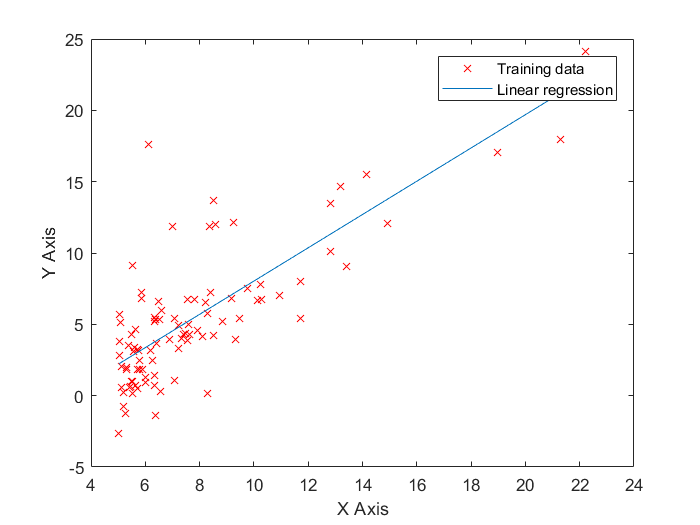
Fig2.\(J(\theta)\)的曲面图像

Fig3.\(J(\theta)\)的等高线图,红叉代表了\(J(\theta)\)最小处的点
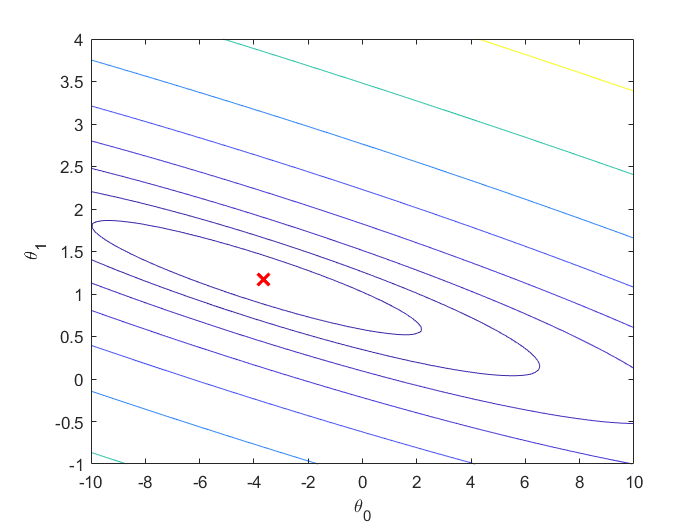
多变量线性回归
featureNormalize
要求:给出m组输入数据的特征(这里特征维数为2),即m行2列矩阵X,将输入数据Z-score归一化到区间[-1,1]。注意,这时还没有给X添加一列1
Z-score归一化方法:
对于第i维特征,计算出m组数据该特征的平均值\(\mu\)和标准差\(\sigma\),则
归一化后每一维特征平均值为0,标准差为1
function [X_norm, mu, sigma] = featureNormalize(X)
%FEATURENORMALIZE Normalizes the features in X
% FEATURENORMALIZE(X) returns a normalized version of X where
% the mean value of each feature is 0 and the standard deviation
% is 1. This is often a good preprocessing step to do when
% working with learning algorithms.
% You need to set these values correctly
X_norm = X;
mu = zeros(1, size(X, 2));
sigma = zeros(1, size(X, 2));
% ====================== YOUR CODE HERE ======================
% Instructions: First, for each feature dimension, compute the mean
% of the feature and subtract it from the dataset,
% storing the mean value in mu. Next, compute the
% standard deviation of each feature and divide
% each feature by it's standard deviation, storing
% the standard deviation in sigma.
%
% Note that X is a matrix where each column is a
% feature and each row is an example. You need
% to perform the normalization separately for
% each feature.
%
% Hint: You might find the 'mean' and 'std' functions useful.
%
mu(1,1)=mean(X(:,1));
mu(1,2)=mean(X(:,2));
sigma(1,1)=std(X(:,1));
sigma(1,2)=std(X(:,2));
X_norm(:,1)=(X_norm(:,1)-mu(1,1))/sigma(1,1);
X_norm(:,2)=(X_norm(:,2)-mu(1,2))/sigma(1,2);
% ============================================================
end
computeCostMulti
要求:给出m组输入数据(m*3矩阵X,每一行第一列为1)和真实输出y,计算用\(y=\theta^TX^{(i)T}\)拟合这些数据的均方误差\(J(\theta)\)
function J = computeCostMulti(X, y, theta)
%COMPUTECOSTMULTI Compute cost for linear regression with multiple variables
% J = COMPUTECOSTMULTI(X, y, theta) computes the cost of using theta as the
% parameter for linear regression to fit the data points in X and y
% Initialize some useful values
m = length(y); % number of training examples
% You need to return the following variables correctly
J = 0;
% ====================== YOUR CODE HERE ======================
% Instructions: Compute the cost of a particular choice of theta
% You should set J to the cost.
for i=1:m
J=J+(theta'*X(i)'-y(i))^2;
end
J=J/(2*m);
% =========================================================================
end
gradientDescentMulti
要求:给出m组数据\((x^{(i)},y^{(i)})\),学习率\(\alpha\),梯度下降法迭代num_iters次后返回最终的参数\(\theta\)和每次迭代后的均方误差损失J_history
注意,这里每个输入数据的第一维特征都是1(后来补上的)
公式推导:
对于第t个参数\(\theta_t\),其更新公式为:
function [theta, J_history] = gradientDescentMulti(X, y, theta, alpha, num_iters)
%GRADIENTDESCENTMULTI Performs gradient descent to learn theta
% theta = GRADIENTDESCENTMULTI(x, y, theta, alpha, num_iters) updates theta by
% taking num_iters gradient steps with learning rate alpha
% Initialize some useful values
m = length(y); % number of training examples
J_history = zeros(num_iters, 1);
for iter = 1:num_iters
% ====================== YOUR CODE HERE ======================
% Instructions: Perform a single gradient step on the parameter vector
% theta.
%
% Hint: While debugging, it can be useful to print out the values
% of the cost function (computeCostMulti) and gradient here.
%
paramsize=length(theta);
dJ_dtheta=zeros(paramsize,1);
for i=1:paramsize
for j=1:m
dJ_dtheta(i,1)=dJ_dtheta(i,1)+(theta'*X(j,:)'-y(j))*X(j,i);
end
end
for i=1:paramsize
dJ_dtheta(i,1)=dJ_dtheta(i,1)/m;
theta(i)=theta(i)-alpha*dJ_dtheta(i);
end
% ============================================================
% Save the cost J in every iteration
J_history(iter) = computeCostMulti(X, y, theta);
end
end
最终测试结果
Fig1.收敛曲线
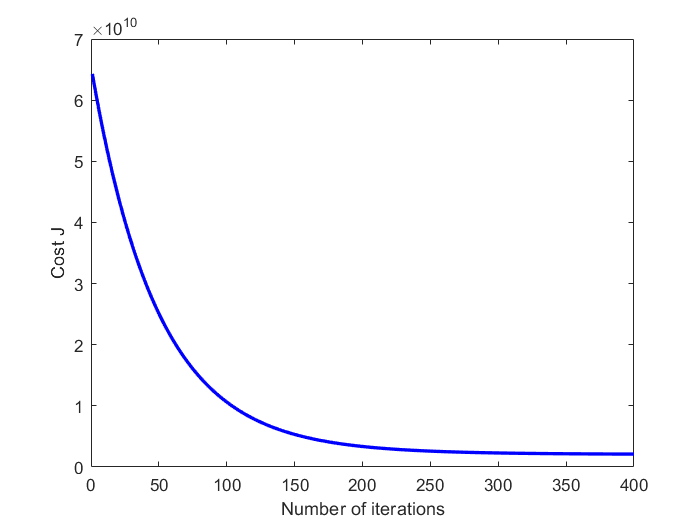
最小二乘法(投影法)求\(\theta\)
对于单变量的线性回归问题,
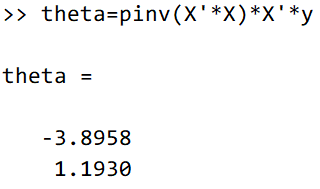
结果与梯度下降法近似。
Programming Exercise 2: Logistic Regression
Logistic回归二分类
plotData
function plotData(X, y)
%PLOTDATA Plots the data points X and y into a new figure
% PLOTDATA(x,y) plots the data points with + for the positive examples
% and o for the negative examples. X is assumed to be a Mx2 matrix.
% Create New Figure
figure; hold on;
% ====================== YOUR CODE HERE ======================
% Instructions: Plot the positive and negative examples on a
% 2D plot, using the option 'k+' for the positive
% examples and 'ko' for the negative examples.
%
m=size(X,1);
pos=find(y==1);
neg=find(y==0);
plot(X(pos,1),X(pos,2),'+','LineWidth', 2,'MarkerSize', 7);
plot(X(neg,1),X(neg,2),'o', 'MarkerFaceColor', 'y','MarkerSize', 7);
% =========================================================================
hold off;
end
sigmoid
Sigmoid函数:
function g = sigmoid(z)
%SIGMOID Compute sigmoid functoon
% J = SIGMOID(z) computes the sigmoid of z.
% You need to return the following variables correctly
g = zeros(size(z));
% ====================== YOUR CODE HERE ======================
% Instructions: Compute the sigmoid of each value of z (z can be a matrix,
% vector or scalar).
g=1/(1+exp(-z));
% =============================================================
end
costFunction
Logistic回归采用交叉熵误差函数:
梯度下降公式推导:
function [J, grad] = costFunction(theta, X, y)
%COSTFUNCTION Compute cost and gradient for logistic regression
% J = COSTFUNCTION(theta, X, y) computes the cost of using theta as the
% parameter for logistic regression and the gradient of the cost
% w.r.t. to the parameters.
% Initialize some useful values
m = length(y); % number of training examples
% You need to return the following variables correctly
J = 0;
grad = zeros(size(theta));
% ====================== YOUR CODE HERE ======================
% Instructions: Compute the cost of a particular choice of theta.
% You should set J to the cost.
% Compute the partial derivatives and set grad to the partial
% derivatives of the cost w.r.t. each parameter in theta
%
% Note: grad should have the same dimensions as theta
%
for i=1:m
J=J+(-y(i)*log(sigmoid(theta'*X(i,:)'))-(1-y(i))*log(1-sigmoid(theta'*X(i,:)')));
end
J=J/m;
for t=1:size(theta)
for i=1:m
grad(t)=grad(t)+(sigmoid(theta'*X(i,:)')-y(i))*X(i,t);
end
grad(t)=grad(t)/m;
end
% =============================================================
end
predict
function p = predict(theta, X)
%PREDICT Predict whether the label is 0 or 1 using learned logistic
%regression parameters theta
% p = PREDICT(theta, X) computes the predictions for X using a
% threshold at 0.5 (i.e., if sigmoid(theta'*x) >= 0.5, predict 1)
m = size(X, 1); % Number of training examples
% You need to return the following variables correctly
p = zeros(m, 1);
% ====================== YOUR CODE HERE ======================
% Instructions: Complete the following code to make predictions using
% your learned logistic regression parameters.
% You should set p to a vector of 0's and 1's
%
for i=1:m
tmp=theta'*X(i,:)';
if(tmp>=0)
p(i)=1;
else
p(i)=0;
end
end
% =========================================================================
end
最终测试结果
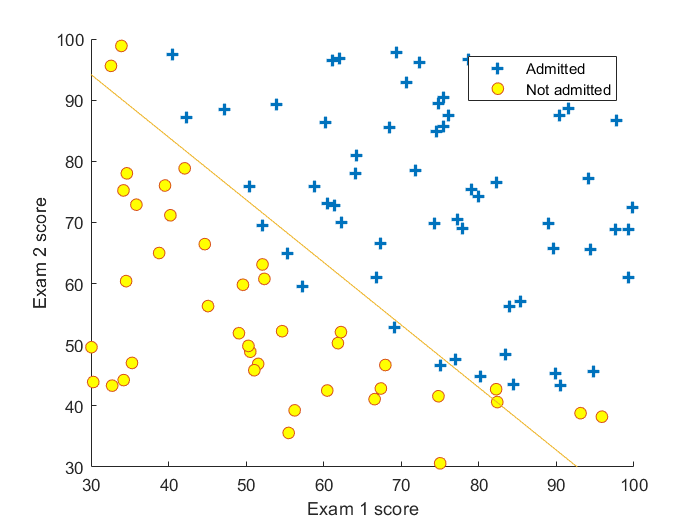
带正则化的Logistic回归二分类
costFunctionReg
带正则化的Logistic回归中,损失函数加入了正则化项
其中\(\lambda\)为惩罚参数,\(\lambda\)越大,\(\theta_1\cdots \theta_n\)越小,\(h_\theta(X)\)越接近\(Sigmoid(\theta_0)\),越不容易过拟合,倾向于欠拟合。注意这里没有把\(\theta_0\)加入正则化项中
梯度下降公式推导:
function [J, grad] = costFunctionReg(theta, X, y, lambda)
%COSTFUNCTIONREG Compute cost and gradient for logistic regression with regularization
% J = COSTFUNCTIONREG(theta, X, y, lambda) computes the cost of using
% theta as the parameter for regularized logistic regression and the
% gradient of the cost w.r.t. to the parameters.
% Initialize some useful values
m = length(y); % number of training examples
% You need to return the following variables correctly
J = 0;
grad = zeros(size(theta));
% ====================== YOUR CODE HERE ======================
% Instructions: Compute the cost of a particular choice of theta.
% You should set J to the cost.
% Compute the partial derivatives and set grad to the partial
% derivatives of the cost w.r.t. each parameter in theta
for i=1:m
tmp=sigmoid(theta'*X(i,:)');
J=J+(-y(i)*log(tmp)-(1-y(i))*log(1-tmp));
end
J=J/m;
regsum=0;
for i=2:size(theta)
regsum=regsum+theta(i)*theta(i);
end
regsum=regsum*lambda/(2*m);
J=J+regsum;
for i=1:m
grad(1)=grad(1)+(sigmoid(theta'*X(i,:)')-y(i))*X(i,1);
end
grad(1)=grad(1)/m;
for t=2:size(theta)
for i=1:m
grad(t)=grad(t)+(sigmoid(theta'*X(i,:)')-y(i))*X(i,t);
end
grad(t)=grad(t)+lambda*theta(t)/m;
end
% =============================================================
end
最终测试结果
Fig.不同\(\lambda\)取值下获得的决策边界
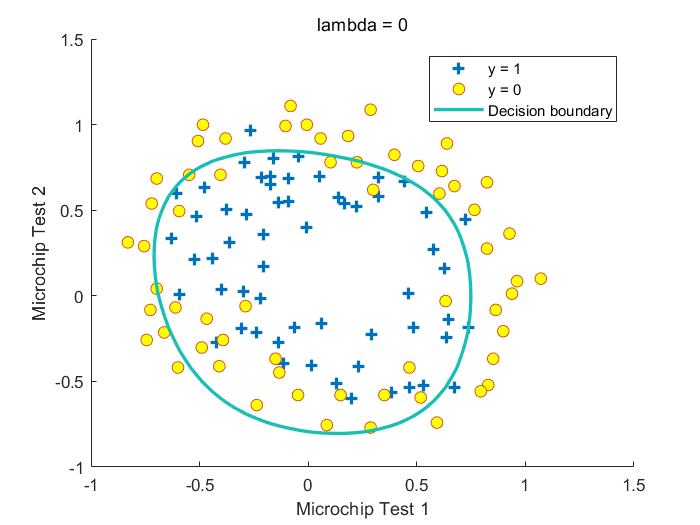
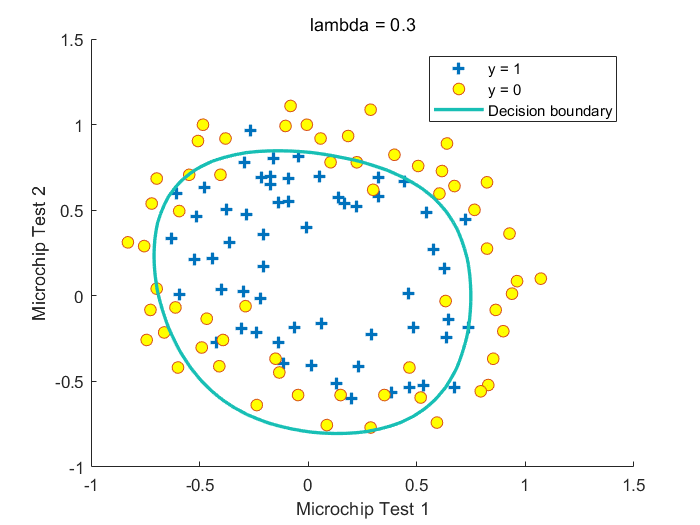
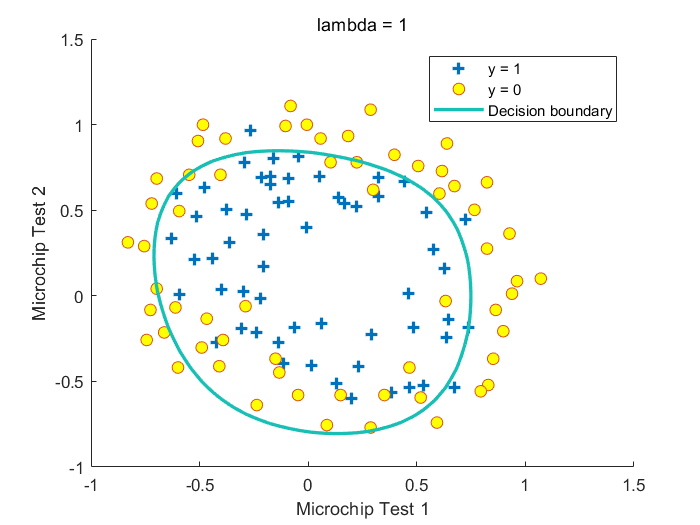
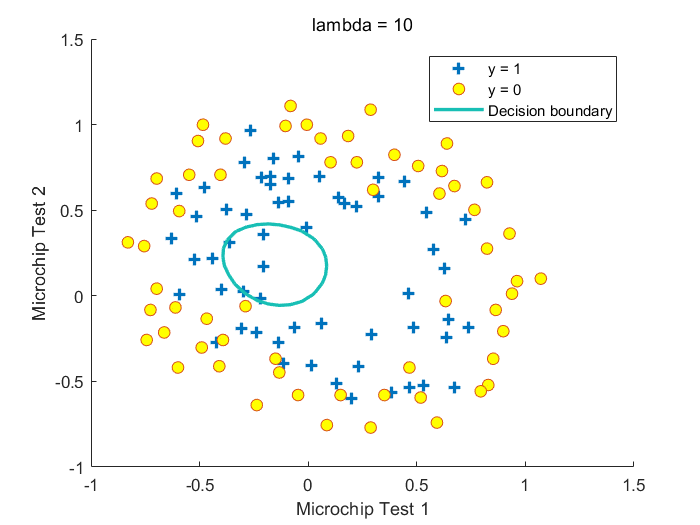


 浙公网安备 33010602011771号
浙公网安备 33010602011771号